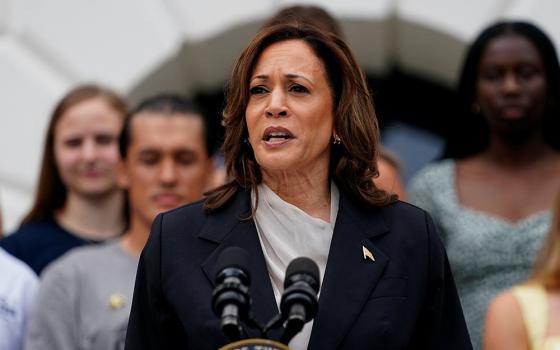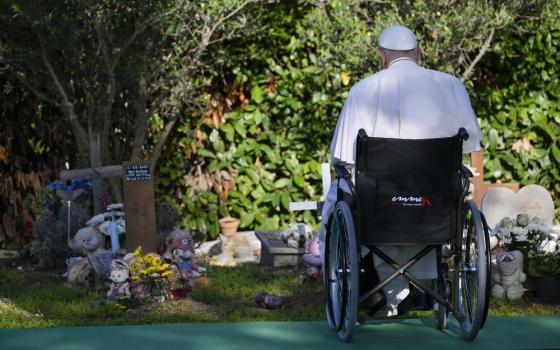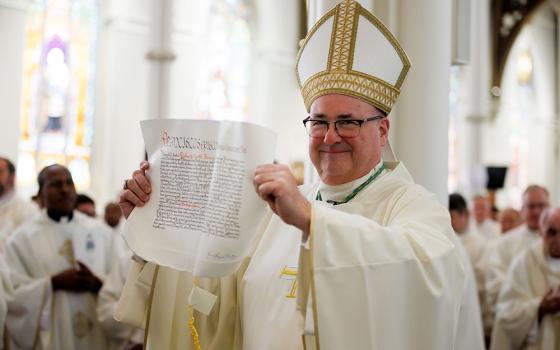WASHINGTON -- Teresa Kettelkamp anticipates that over the next few years every article in the U.S. bishops' 2002 "Charter for the Protection of Children and Young People" will come to be viewed as the commonly expected practice in dioceses, parishes, schools and other church organizations. Catholics will say, "This is what we do."
The bishops adopted the charter during a 2002 meeting in Dallas after reports of sexual abuse of minors by priests swept the nation.
"If complacency and issue fatigue don't take over, which is a problem in any organization, what I anticipate seeing is an integration of the charter articles into the culture of the church," Kettelkamp said in a May 13 interview. She is executive director of the Secretariat of Child and Youth Protection at the U.S. Conference of Catholic Bishops.
Today, nearly nine years after the charter's adoption, there is "no tolerance" in the church for the sexual abuse of minors, Kettelkamp emphasized.
In the nine years ahead, however, if not much sooner, Kettelkamp hopes Catholics will become so "used to" what the charter demands that they "will have the expectation" that youth ministers receive safe environment training and background checks, and that the church has a code of conduct for those working with minors.
Among its 17 articles, the charter mandates policies and procedures for responding to abuse allegations. Also mandated are clear standards for those in the church in regular contact with minors, as well as safe environment programs for children and adults aimed at preventing abuse.
Assessing the effectiveness of each charter article remains important, but the next step is for this effectiveness to become routine, Kettelkamp said.
The real reason for doing "what we do in the charter" is not simply because this is required, but because "we are Christians, Catholics," she said.
There is no single cause of the sexual abuse of minors, Kettelkamp said. "It's a huge, complex issue." In her opinion, very rarely "are things this big caused by one thing."
She acknowledged that this makes addressing the problem "more complex." If there were a single cause, "we could assess whether we've gotten rid of the cause," she explained.
The interview with Kettelkamp took place just before the release in Washington of a long-awaited report on a major study of the causes and context of clergy sexual abuse of minors. The study was commissioned by the National Review Board, a lay, consultative body created in 2002 under the bishops' charter.
Without discussing details of the report, she said the U.S. bishops wanted to know "what caused this crisis" in order to "look at the charter" and ask, "Are we doing what needs to be done, and if we're not doing what needs to be done, what needs to be fixed?"
But "if we're doing things that are right, we need to know that too," she said.
The causes and context study will be "totally put to use," according to Kettelkamp. "This is not just something so that the bishops can say we did this, check and close the book." She added, "The National Review Board would never allow that."
"We do not have a sexual abuse crisis in the church at this time," Kettelkamp said. The bulk of clergy abuse incidents took place in the 1960s and 1970s.
However, in accenting the "historical" nature of the crisis, Kettelkamp said she in no way wanted victims of abuse in the 1960s and 1970s who might yet find the courage to come forward to be "minimized or dismissed."
Though a situation of "no tolerance" for sexual abuse of minors has developed in the church, Kettelkamp said work remains to be done. "I'm not saying we're where we need to be," she said.
With the new study's findings in hand, Kettelkamp's office will work at "ascertaining the effectiveness of each article" of the bishops' charter. She said it is "one thing to have policies and procedures," but there is a need to assess whether they are working.
There always will be some sexual abuse of minors, Kettelkamp said. But she believes the "learning level" in the church today is "much higher than it was" 10, 20 and 30 years ago. "We really have a good grasp, I think, on how to keep children safe," she said.
[Gibson was the founding editor of Origins, Catholic News Service's documentary service. He retired in 2007 after holding that post for 36 years.]
Editor's Note: The full text of the John Jay report is now available as a pdf file: Causes and Context of Sexual Abuse of Minors by Catholic Priests in the United States, 1950-2010
For more coverage of the John Jay report, see:
- Bishops at center of abuse scandal, and potential reform, RNS, May 18
- Report spreads blame for Catholic sex abuse, RNS, May 17
- Diocesan programs help build 'safety barriers' against child abusers, CNS, May 18 2011
- No room for complacency in protecting children from abuse, bishop says, CNS, May 18 2011
- US bishops say new John Jay report on abuse key to understanding issue, CNS, May 18 2011
- Key quotes from National Review Board's 'causes and context' report, CNS, May 17 2011
- Key events in US church response to clergy sex abuse crisis, CNS, May 17 2011
- Bishops' child protection officer looks to church's next steps on abuse, CNS, May 17 2011
- Misperceptions of abuse problem common, John Jay report says, CNS, May 17 2011
- Major recommendations from 'causes and context' report on abuse, CNS, May 17 2011
- Causes and context report released on clergy sexual abuse of minors, CNS, May 17 2011



